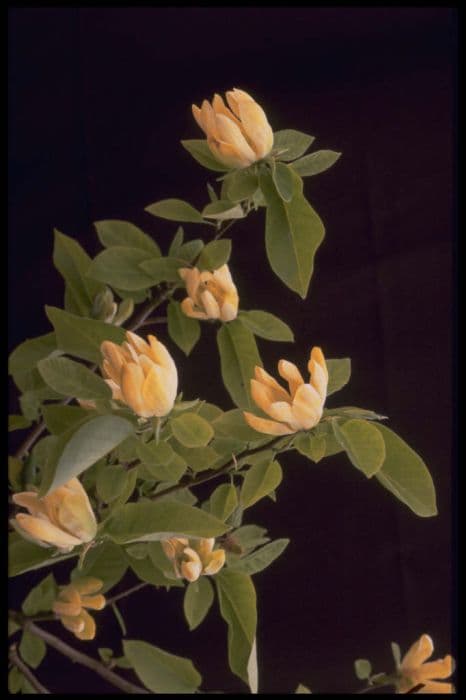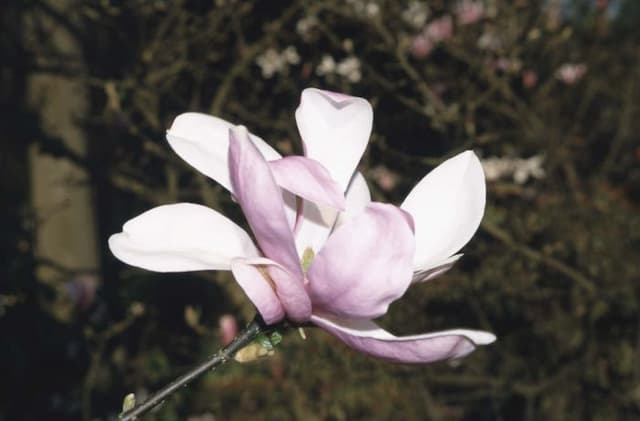Sweet Michelia Magnolia doltsopa

ABOUT
Magnolia doltsopa, commonly known as sweet Michelia, is a visually striking plant that is widely admired for its aesthetic appeal. The appearance of the sweet Michelia is characterized by a robust and evergreen nature, with glossy, dark green leaves that are elongated and leathery to the touch. The foliage provides a year-round backdrop of lush greenery which can serve as an attractive element in any garden setting. The most captivating feature of the sweet Michelia is its flowers; they bloom profusely and are highly aromatic, with an intoxicating fragrance that can fill the surrounding air. The flowers are large, creamy-white, and cup-shaped, often appearing in clusters that enhance the plant's decorative effect. Each individual flower consists of a series of delicate petals that radiate from the center, enveloping the plant's reproductive organs. These blossoms are notable not just for their size and scent, but also for their texture – silky and smooth to the touch. The flowers emerge primarily during the late winter or early spring months, signaling the end of the colder season with their striking appearance and scent. Aside from its blooms, the sweet Michelia may produce cone-like fruit that houses seeds, which are generally not the main focus when cultivating the plant for ornamental purposes. Nevertheless, the fruit adds an additional layer of interest to the plant's morphology. Overall, the sweet Michelia is a magnificent plant that exudes elegance and beauty through its dark green, leathery leaves and sizeable, fragrant flowers, making it a cherished specimen for gardens and landscapes where it is suitable to grow.
About this plant
 Names
NamesFamily
Magnoliaceae.
Synonyms
Sweet Michelia, Doltsopa, Chinese Magnolia.
Common names
Michelia doltsopa, Magnolia excelsa, Michelia excelsa, Michelia manipurensis, Magnolia manipurensis.
 Toxicity
ToxicityTo humans
Sweet Michelia is not commonly listed as a toxic plant to humans. There are no widespread reports of poisoning or significant toxic effects from ingestion of Sweet Michelia. However, as with any plant, individual allergies or sensitivities could cause mild irritation or discomfort if ingested or handled, and care should always be taken when trying any plant material that you are not familiar with.
To pets
Sweet Michelia is generally not known to be toxic to pets. There are no well-documented cases of pet poisoning from ingestion of this plant. However, each animal might react differently to various plants or foreign substances, so it is always prudent to monitor pets and prevent them from consuming plants not intended for their consumption. If you suspect your pet has ingested any part of the Sweet Michelia and is showing signs of distress, it is best to consult a veterinarian.
 Characteristics
CharacteristicsLife cycle
Perennials
Foliage type
Evergreen
Color of leaves
Green
Flower color
White
Height
20-30 feet (6-9 meters)
Spread
15-20 feet (4.5-6 meters)
Plant type
Tree
Hardiness zones
7-9
Native area
Himalayas
Benefits
 General Benefits
General Benefits- Aesthetic Appeal - The Magnolia doltsopa, commonly known as Sweet Michelia, is appreciated for its striking beauty and elegant, large white flowers which can enhance the visual attractiveness of a garden or landscape.
- Fragrance - Sweet Michelia is well-known for its intense and pleasant fragrance, which can create a delightful and aromatic environment in areas where it is planted.
- Shade Provider - It can grow into a medium to large-sized tree, providing ample shade during hot weather, making it useful for creating cool, shaded areas in gardens and parks.
- Habitat for Wildlife - The tree can serve as a habitat and provide food for various bird species and insects, contributing to biodiversity conservation.
- Acoustic Barrier - When planted in groups, Sweet Michelia can act as a natural sound barrier, absorbing and reducing noise pollution, making it suitable for urban gardens near noisy areas.
- Cultural Significance - In various cultures, Sweet Michelia is often associated with nobility and purity and is used in traditional festivities and ceremonial events, enriching cultural practices.
- Timber Value - Although not primarily grown for timber, the wood of Sweet Michelia is hard and durable and can be used for construction, furniture, and craft when trees are harvested sustainably.
 Medical Properties
Medical Properties- Anti-inflammatory: Magnolia doltsopa may have components that help reduce inflammation.
- Antioxidant: The plant could have compounds with antioxidant properties that combat oxidative stress.
- Anxiolytic: It may possess anxiolytic effects, potentially reducing anxiety.
- Neuroprotective: Magnolia doltsopa might have neuroprotective effects, aiding in the protection of nerve cells.
- Anti-cancer: Some studies suggest that constituents of this plant could have anti-cancer properties.
- Antimicrobial: There are indications that the plant has antimicrobial activity that can combat certain bacteria and fungi.
 Air-purifying Qualities
Air-purifying QualitiesThis plant is not specifically known for air purifying qualities.
 Other Uses
Other Uses- Perfumery: Magnolia doltsopa's flowers have a strong fragrance which is used in the production of perfumes and scented oils.
- Cultural Symbolism: In certain cultures, the flowers of the Magnolia doltsopa may be used in religious rituals or as symbols for purity and nobility.
- Ornamental Use: Due to its large, showy flowers, the Magnolia doltsopa is widely planted as an ornamental tree in gardens and parks.
- Horticultural Breeding: It is used in cross-breeding to create new varieties of ornamental plants with desired traits such as hardiness and floral characteristics.
- Culinary Garnish: Although not commonly consumed, the flowers can occasionally be used as an edible garnish for special dishes in high-end culinary presentations.
- Soundproofing: The dense, evergreen foliage of Magnolia doltsopa can contribute to soundproofing when planted in thick hedges or rows near noisy areas.
- Woodworking: The wood of Magnolia doltsopa is sometimes used for making small wooden objects, like ornamental boxes or utensils.
- Photography: The tree's striking presence and beautiful flowers make it a popular subject for professional and amateur photographers alike.
- Educational Tool: Botanical gardens may include Magnolia doltsopa to educate people about plant diversity and the Magnoliaceae family.
- Street Trees: Magnolia doltsopa is sometimes planted along streets in urban areas for its aesthetic appeal and shade-providing canopy.
Interesting Facts
 Feng Shui
Feng ShuiThe Sweet Michelia is not used in Feng Shui practice.
 Zodiac Sign Compitability
Zodiac Sign CompitabilityThe Sweet Michelia is not used in astrology practice.
 Plant Symbolism
Plant Symbolism- Perseverance and Endurance: The Magnolia doltsopa, also commonly known as Sweet Michelia, is known for its tough, hardy nature and ability to withstand tough conditions. This symbolic meaning springs from the plant's natural resilience and persistence in blooming even in the harshest climates.
- Dignity and Nobility: With its elegant and glossy leaves along with the large, beautiful flowers it produces, the Sweet Michelia is often associated with a sense of dignity and nobility. This reflects the high esteem in which the magnolia family has traditionally been held, often found in the gardens of the affluent and in historically rich areas.
- Purity and Innocence: The sophisticated and delicate white flowers of the Sweet Michelia often symbolize purity and innocence, qualities typically attributed to the magnolia blooms reflecting untainted beauty.
- Courage and Honor: Due to its strong nature and association with noble values, the Sweet Michelia can also represent courage and honor, suggesting an inner strength and a commitment to personal ethics and integrity.
 Water
WaterSweet michelia needs to be watered deeply, with about 1 to 1.5 gallons of water, ensuring that the soil is moist but not waterlogged. During the growing season, water the plant once a week, but adjust frequency during hotter, drier periods to possibly twice a week. In winter, reduce watering to every two weeks or less, depending on the climate and soil drainage. Always check the top few inches of soil for dryness before watering again.
 Light
LightSweet michelia thrives in full sun to partial shade. The ideal spot for this plant is one where it can receive several hours of direct sunlight each day, with some dappled shade during the hottest part of the afternoon. Avoid deep shade locations as this can impact flowering and overall growth.
 Temperature
TemperatureThe sweet michelia prefers temperatures between 60°F and 80°F but can tolerate a range from around 50°F to 90°F. It is not frost-hardy, so it should be protected from temperatures below 50°F. Ideally, keep the plant in a location where the temperature does not fluctuate widely, as this can stress the plant.
 Pruning
PruningPrune sweet michelia to maintain its shape and remove any dead or diseased wood. It is best to prune this plant after it has finished blooming in late spring or early summer. Light pruning can be done annually, but a more thorough shaping should be done every two to three years.
 Cleaning
CleaningAs needed
 Soil
SoilSweet Michelia prefers well-draining, fertile soil with a pH of 5.5-6.5. Mix loam, peat, and sand in equal parts for the best soil conditions.
 Repotting
RepottingSweet Michelia typically requires repotting every few years, usually in the spring before the growing season begins.
 Humidity & Misting
Humidity & MistingSweet Michelia thrives in high humidity conditions, ideally around 50-60% relative humidity.
 Suitable locations
Suitable locationsIndoor
Place Sweet Michelia in bright, indirect light indoors, ensuring high humidity.
Outdoor
Plant Sweet Michelia in partial shade with protection from strong winds.
Hardiness zone
Sweet Michelia is suited for 7-10 USDA.
 Life cycle
Life cycleThe life cycle of Magnolia doltsopa, commonly known as Sweet Michelia, begins with seed germination, which requires a warm, moist environment to break dormancy. Seedlings emerge with a pair of initial leaves and gradually develop a woody stem as they mature into young plants. During its juvenile phase, Sweet Michelia exhibits rapid vegetative growth and prepares to flower, but it may take several years before the first blooms appear. Flowering typically occurs in late winter or early spring, with the plant producing fragrant, creamy-white flowers that attract pollinators. After pollination, the flowers develop into fruit, which are aggregates of follicles containing seeds that are dispersed by gravity and potentially by animals. The Sweet Michelia can live for many years, continuing the cycle of growth, flowering, and fruiting, potentially reaching considerable heights and widths as a mature tree.
 Propogation
PropogationPropogation time
Spring to Summer
The most popular method of propagating Magnolia doltsopa, commonly known as Sweet Michelia, is through semi-hardwood cuttings. This technique is typically performed in late summer after the flush of spring growth has matured. Cuttings about 4 to 6 inches (10 to 15 centimeters) in length are taken with several leaves attached, and the lower leaves are removed. The cut end of the cutting is treated with rooting hormone to encourage root development and then planted in a mix of sand and peat moss to provide good drainage and moisture retention. The cuttings are kept under high humidity, such as in a misting chamber, and at temperatures between 70 to 75 degrees Fahrenheit (21 to 24 degrees Celsius) until roots develop, which can take several weeks to a few months. It is crucial to keep the cuttings well-watered and to avoid direct sunlight during this rooting period.

![Magnolia [Fairy Blush]](/_next/image?url=https%3A%2F%2Fplants-admin.emdemapps.com%2Fimages%2Fplants%2F%2Fimages%2F604b5a108e959.png&w=640&q=75)







![Magnolia [Black Tulip]](/_next/image?url=https%3A%2F%2Fplants-admin.emdemapps.com%2Fimages%2Fplants%2F%2Fimages%2F604b590290fc7.png&w=640&q=75)